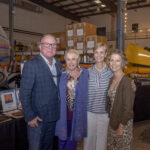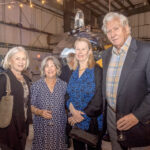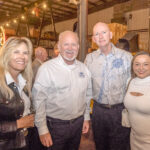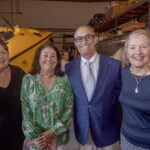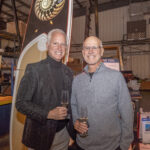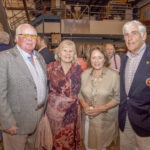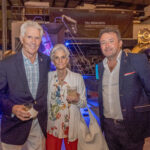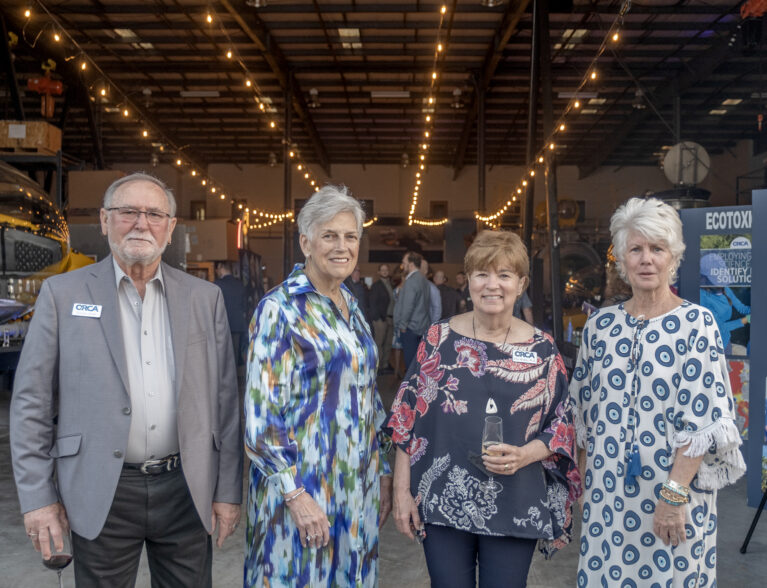
A fundraiser at an industrial facility might sound unusual, but the ORCA Explorer’s Experience at Triton Submarines was the perfect way to highlight the focus of the Ocean Research & Conservation Association. ORCA uses science-based methods and innovative technologies to protect and restore aquatic ecosystems, from our own Indian River Lagoon to the world’s vast oceans.
As guests mingled over cocktails and hors d’oeuvres, they explored the remarkable subs, and viewed videos of deep-sea dives and the extraordinary creatures therein.
“I’ve made countless dives in some of the subs that you see here, and they changed the course of my career,” said Edith (Edie) Widder, Ph.D., ORCA founder and CEO, before thanking Patrick Lahey, Triton president/CEO, and his team for the unique opportunity to view “these amazing tools for deep sea exploration.”
Widder introduced Tasha Van Zandt, who is producing the documentary ‘A Life Illuminated’ with Sebastian Zeke, and said she had been on a dive in the Azores with them this past fall aboard a Triton submersible.
Van Zandt related that the experience was so remarkable that it was “hard to even put into words; it was really life changing.”
“While our subs can be used recreationally, we love it when they’re being used to create compelling films that captivate people’s imagination, and get people excited about the very place that I’m in love with,” said Lahey.
Referencing their various subs, he pointed out versions that have been used for documentaries by James Cameron and Mike McDowell, for research by Ray Dalio on his OceanXplorer, and the Triton 3300/6 which is slated for the Scenic Eclipse II cruise ship.
Their Pagoo, the only sub that can carry 10 people and dive to 1,200 feet, is even equipped with a galley and a head, and their latest, the Triton 660/9 AVA, has a unique elliptical pressure boundary for a more immersive experience.
“We want to build these extraordinary machines that allow people to experience the wonder and beauty of the deep sea. Edie was one of the largest users of submersibles and she understands their capacity to excite and generate interest in our oceans in a way that no other tool can,” said Lahey. He stressed that, unlike experimental craft, their submersibles are 100 percent certified and accredited.
During dinner, Widder thanked everyone, and referenced Trudie Rainone, whose generosity made their new headquarters possible. The D.J. Rainone Research & Science Center is named in memory of her late son, an ocean conservation advocate.
Widder said she founded ORCA “to try to give back to the ocean I love,” calling it the largest living space on the planet, and its least explored.
Closer to home, ORCA is working to improve the health of the lagoon, once the most biologically diverse estuary in the country. As a place where marine life spawns, it has an enormous impact on the oceans’ wellbeing.
“Undoubtedly it is the most vital waterway to us; it is the lifeline of our region,” said Missy Weiss, ORCA director of Citizen Science and Education.
They are working to protect and restore the lagoon through applied science research, such as using Kilroys, a network of real-time water monitoring devices to determine ecotoxicity and One Health issues with comprehensive pollution mapping.
To engage the next generation, ORCA educates students through mentorships and their ‘A Day in the Life of the Indian River Lagoon’ initiative, which has some 2,000 students descend on the lagoon on a single day to collect the same types of research and data as research scientists.
For more information, visit TeamORCA.org.
Photos by Joshua Kodis
- George Jones, Trudie Rainone, Edie Widder and Michelle Martin.
- Chip Hughes, Mary Lewisy, Sandy Hughes and Patti Walters.
- Piggotty Gilson, Trish Bailey, Carla Meyer and Vin Ryan.
- Nina Elo-Piacquad and Ron Stamm with Anthony and Marcia Ware.
- David Mac with Patrick and Tiziana Lahey and John Bacon.
- Clarke Bailey and Herb Fitz Gibbon.
- Ed Shanaphy and Sophie Bentham-Wood.
- Grant Stutz and Christie Freseman.
- Will McCartney, Veronica Cancio and Chad Baesman.
- D. R. Widder and Missy Weiss.
- Jen Cole with Robin and Jack Mandato and Lauren Michael.
- Jack and Robin Mandato.
- Claudia Owen, Bob Formisano and Barbara Diemer.
- Juanita and Richard Baker.
- Alex Dechellis, Tayor Seubert and Anthony Dechellis.
- George Bisset and Bob Bisset.
- George and Elke Fetterolf with Anne and Walt Noonan.
- Susan and Rick Hahn.
- Laura and John Loesser.
- Carol and Bob Lincoln.
- Jamie and Coo Murray with Craig Barnett.
- Virginie Hoos and Mary Castlow.


